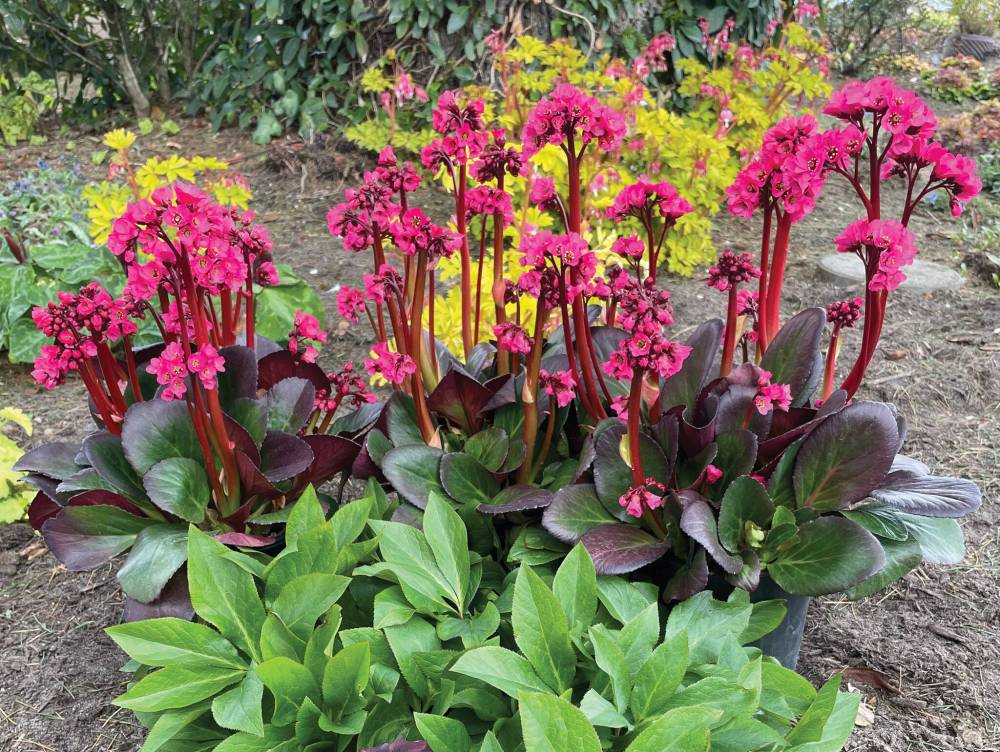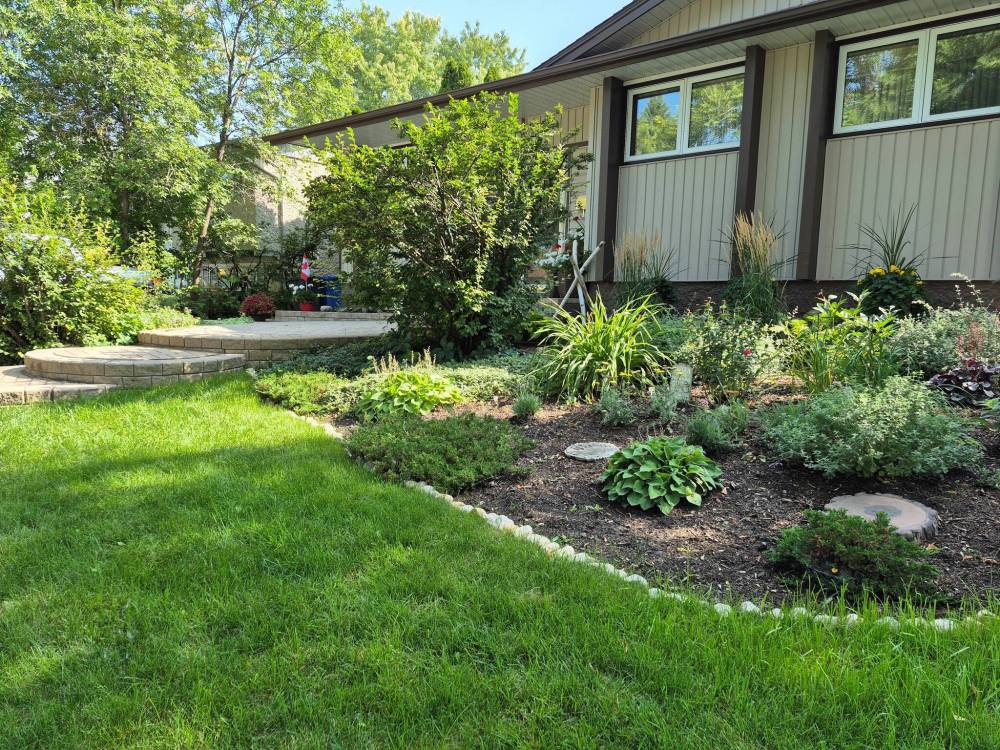A front yard is reborn
How a shady pollinator desert became a flower-filled haven
Advertisement
Read this article for free:
or
Already have an account? Log in here »
To continue reading, please subscribe:
Monthly Digital Subscription
$0 for the first 4 weeks*
- Enjoy unlimited reading on winnipegfreepress.com
- Read the E-Edition, our digital replica newspaper
- Access News Break, our award-winning app
- Play interactive puzzles
*No charge for 4 weeks then price increases to the regular rate of $19.00 plus GST every four weeks. Offer available to new and qualified returning subscribers only. Cancel any time.
Monthly Digital Subscription
$4.75/week*
- Enjoy unlimited reading on winnipegfreepress.com
- Read the E-Edition, our digital replica newspaper
- Access News Break, our award-winning app
- Play interactive puzzles
*Billed as $19 plus GST every four weeks. Cancel any time.
To continue reading, please subscribe:
Add Free Press access to your Brandon Sun subscription for only an additional
$1 for the first 4 weeks*
*Your next subscription payment will increase by $1.00 and you will be charged $16.99 plus GST for four weeks. After four weeks, your payment will increase to $23.99 plus GST every four weeks.
Read unlimited articles for free today:
or
Already have an account? Log in here »
Drive through any older, established neighbourhood in Winnipeg and you will see fully grown evergreen trees that dominate small front yard landscapes, often completely blocking houses from view. Decades ago, when the trees were small, they probably seemed like a very good idea.
While the growth rate of an evergreen tree is slow initially, it picks up once the tree is established. When conditions are optimum (full sun, well-drained soil), an evergreen can reach an impressive height of 19 metres and a spread of 7.5 metres — an elegant feature on a spacious lot but not ideal for a small urban property.
When Dawn Hicks and her husband purchased their bungalow on a quiet street in south Winnipeg in 1985, they inherited three existing evergreen trees that the previous owner had planted in the front yard. Nearly 40 years later, the trees had grown into monsters, their extensive root systems sapping moisture and nutrients from nearby perennials and plunging the Hicks’ 16-metre-wide front yard into deep shade with their spreading branches.

Terra Nova Nurseries photo
A long-lived perennial, Bergenia Vintage Rose features glossy leaves and large clusters of bright rose flowers in spring.
Shaded by boulevard trees, the aging evergreens started to decline.
“When the lower branches began dying,” says Hicks, “we trimmed them off, but every year we needed to trim more.”
The evergreens also began to heavily shed needles which filled the house gutters.
“We’d have to get up on a ladder regularly to clean out the gutters until we finally decided it was time to remove the trees.”
In 2024, a professional tree service removed the trees as well as the stumps.
Immediately, the deeply shaded front yard was transformed into a sun-filled blank slate ready to be made into the flower-filled haven for pollinators that Hicks had always dreamt about.
Hicks is a master gardener. As an active member of the Manitoba Master Gardener Association and the Herb Society of Manitoba, she has spent many hours providing research-based gardening advice to the public. Now, Hicks is excited to start her own garden makeover.

Colleen Zacharias photo
After the removal of three massive evergreens past their prime, this Winnipeg front yard has transitioned from deep shade to a sunny garden filled with pollinators.
“The tree service recommended that we wait a year before replanting,” says Hicks.
After tree removal, microbial life in the soil needs time to recover and the ground needs time to settle. But in addition, even though tree services remove much of the debris after stump grinding, large amounts of wood chips, pieces of roots and sawdust debris remain in the soil.
After filling several yard waste bags with the debris, Hicks set about the business of building healthy, sustainable soil. She incorporated Sea Soil, an organic soil amendment which consists of fish and forestry fines blended and composted for two years. Last fall when Hicks emptied out her planters, she reused the peat-based potting soil mixed with compost and worked it into the new bed.
To assist her in determining which types of plants would thrive in her new garden space, Hicks began by monitoring the light conditions.
“I didn’t want to install a new plant and then have to take it out because the amount of sunlight didn’t match the plant’s light requirements,” says Hicks, “so I tracked the sun’s path in the morning, afternoon and evening to see how much sunlight each area of the garden received.”
After three-plus decades of deep shade where few plants survived in the poor soil beneath the evergreen trees, Hicks wanted her new garden to be rich in colour and textures.
“I wanted lots of flowers and for the new garden to be very bright. I decided upon a colour theme of light blue, pink and yellow.”

Colleen Zacharias photo
Dawn Hicks tends to a favourite perennial, Heuchera coral bells, in her new garden.
Her inspiration was ignited when she came across a book called The Perennial Matchmaker — Create Amazing Combinations With Your Favourite Perennials by Nancy J. Ondra (Rodale, 2016). This how-to guide includes tips on picking perennial partners along with crafting colour combinations, textures and shapes, and how to troubleshoot perennial combinations that don’t always play well together.
“It is the greatest book,” says Hicks. “I really like catmint, bee balm, Karl Foerster feather reed grass, peonies, daylilies and coral bells. The book gave me ideas about which plants to combine them with.”
Hicks has been steadily planting since spring. She has visited garden centres across the city and taken advantage of late summer plant sales. She has relocated plants from her backyard, such as Three Tiers daylily, a classic beauty first introduced in 1971 that has large golden yellow flowers. Hicks purchased three at Lacoste Garden Centre more than 20 years ago. Friends have also gifted plants that have special significance, such as an ostrich fern (Matteuccia struthiopteris) originally owned by the owners of The Mad Nomad, a Winnipeg furnishing shop that closed in 1998.
Hicks, a retired high school principal, is meticulous about keeping records. She records the details of all her perennials on a spreadsheet, including a plant’s common and botanical name, flower colour, quantity, placement and when and where it was obtained.
In her selection and placement of plants, Hicks has paid special attention to making a layered garden with different heights and textures as well as seasonal colour.
At the front of the new bed is the Prince of Wales juniper, a low-growing evergreen groundcover, which Hicks planted in a staggered grouping of three. (She is still searching for a low-growing groundcover to plant between Prince of Wales).
Nearby, a river of Vinca minor with periwinkle-blue flowers in spring over a dense mat of glossy, evergreen leaves flows at an angle towards the back of the garden.

Bailey Nurseries photo
Hardy to zone 2, Blizzard Mock Orange is a 2-metre tall shrub that is covered in masses of fragrant white flowers in June.
Rock soapwort (Saponaria ocymoides), which forms a slowly spreading carpet with pink flowers in spring, is planted on the upper slope because its roots need moisture to drain away quickly.
Hicks recently purchased Bergenia Vintage Rose, commonly known as pigsqueak. This long-lived spring blooming perennial features large clusters of bright rose flowers held above glossy green foliage.
A single specimen of Blizzard Mock Orange (Philadelphus lewisii) will bring height to the garden — mature size is two metres tall — and a gorgeous display of fragrant white flowers throughout June.
From early to mid-summer, the globe-shaped blooms of Monarda bee balm in pink and raspberry will provide textural contrast with the spiky upright purple-blue flowers of Liatris spicata Blazing Star. Hicks planted a dozen Blazing Star but only two bee balm plants.
“Bee balm is one of my favourite perennials, but it is prone to mildew and needs plenty of air circulation,” says Hicks.
The fine texture of the deeply cut foliage of Astilbe Younique Carmine and Achillea millefolium Rosa Maria yarrow complement one another. These floriferous varieties bloom in succession with flowers in shades of pink.
Three substantial clumps of Nepeta catmint have proven to be magnets for bees. “We never had bees in our front yard before and really enjoy watching them at work,” says Hicks.

Ball Horticultural photo
For late summer colour, try Echinacea PowWow Wild Berry coneflower. The seedheads provide vital food for birds in winter.
Karl Foerster feather reed grass planted at the back of the border and Echinacea PowWow Wild Berry coneflower bring beautiful colour to the late season garden and provide vital food and shelter for pollinators during the winter.
So far, Hicks’ new garden contains 55 plants. And she’s not done yet. Next spring, the 55 tulip and daffodil bulbs that she’s planted will create a welcoming display of pink and yellow flowers.

Colleen Zacharias
Gardening columnist
Colleen Zacharias writes about many aspects of gardening including trends, plant recommendations, and how-to information that is uniquely relevant to Prairie gardeners. She has written a column for the Free Press since 2010 and pens the monthly newsletter Winnipeg Gardener. Read more about Colleen.
Every piece of reporting Colleen produces is reviewed by an editing team before it is posted online or published in print — part of the Free Press‘s tradition, since 1872, of producing reliable independent journalism. Read more about Free Press’s history and mandate, and learn how our newsroom operates.
Our newsroom depends on a growing audience of readers to power our journalism. If you are not a paid reader, please consider becoming a subscriber.
Our newsroom depends on its audience of readers to power our journalism. Thank you for your support.

